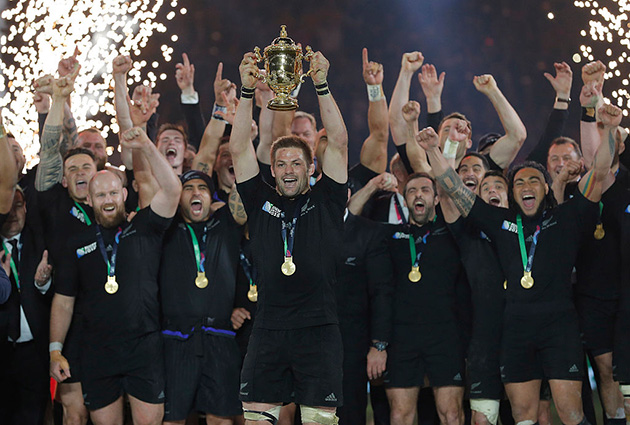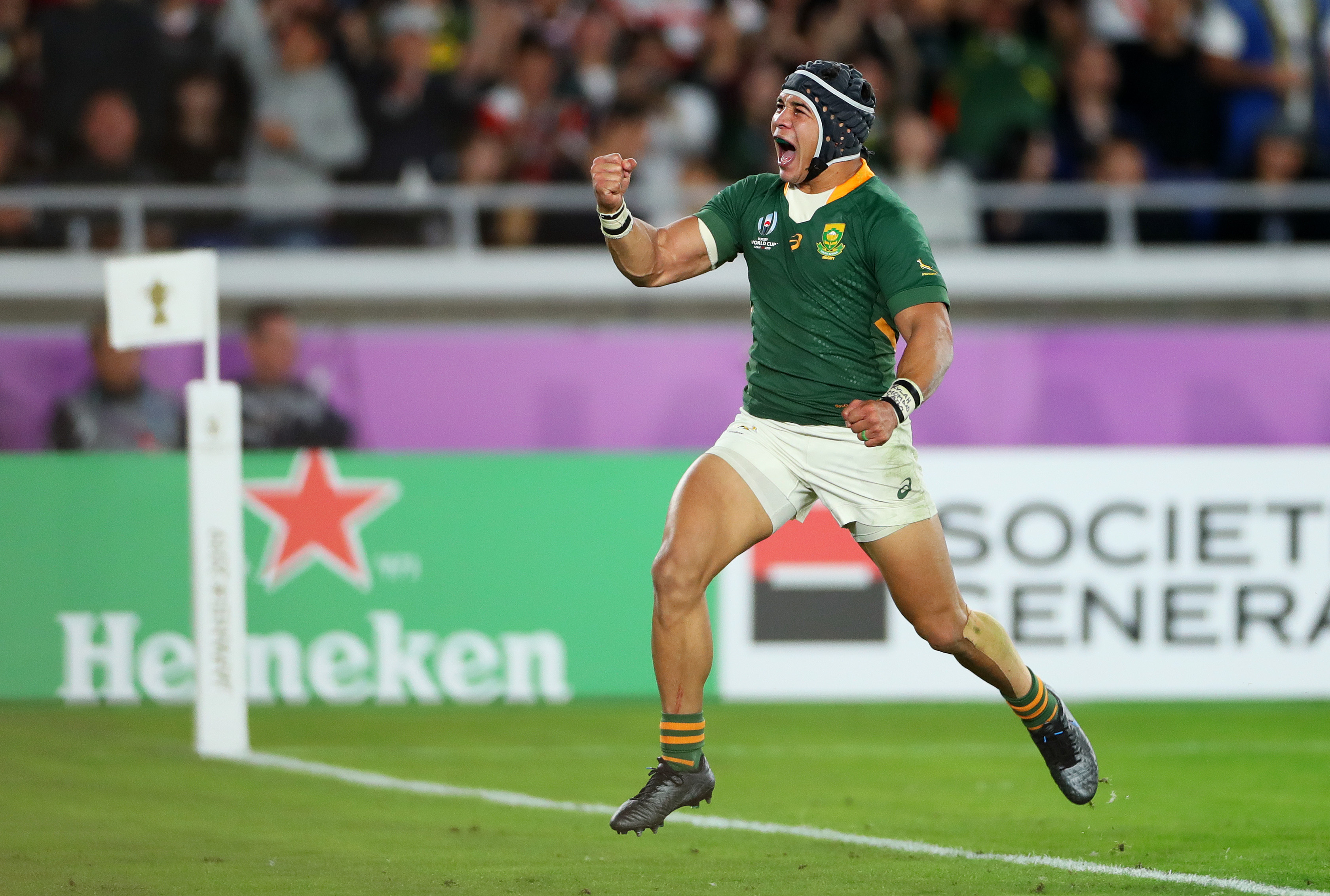Jacob Whitehead runs through his highlights of the 2003 World Cup – and they don't include Jonny Wilkinson's drop-goal
A Love Letter to the 2003 Rugby World Cup
IMBd claims that The Godfather is the greatest film of all time. They are wrong. That honour belongs to the 2003 Rugby World Cup Review, in all its faded, pixelated, questionably soundtracked glory. Watching it is to dive into nostalgia, to dine once again with an old lover, to feel the warm glow of a midnight whiskey spread across your chest.
Yet England’s eventual triumph has blurred our collective memory. The second Jonny Wilkinson’s drop-goal sailed between the posts, our recollection of the tournament was condensed into that one single overriding moment. It had far more than that, from the radiance of Rupeni Caucaunibuca to religious reconciliation – the least interesting part of the tournament was the eventual triumph of the pre-tournament favourites!
The tone was set from the opening ceremony, usually a completely forgettable contrivance – can anybody remember the pre-game rituals of Twickenham in 2015? But Sydney’s offering made us feel like we were living in 2103.
Hundreds of fluorescent drummers evoked an Antipodean Daft Punk, whilst the suit jackets of the performers, comprised of the giant sublimated flags of competing nations, were the greatest fashion innovation to not yet grace the pages of Vogue. On this topic, that 2003 was the last tournament with old-school baggy cotton shirts is a travesty I’ll never quite recover from.

Nostradamus: RWC 2003 predicts the future to show Félix Lambey scoring the winning try for France in in the 2023 World Cup final (Getty)
To the rugby, and the opening days were lit up by players stamping their mark on the international stage. Dan Carter tore apart Italy with impunity, whilst Matt Giteau scored three tries as Australia romped to a 142-0 win over Namibia – the largest margin in World Cup history.
Yet the underdog wasn’t always mauled remorselessly, as some of the best games of the pool stages show. For example, permit me a brief divergence to talk about the one team I promised I wouldn’t. England. And when I say England, I truly mean Samoa.
Samoa led 10-0 against the eventual winners and then 16-10 thanks to one of the tries of the tournament from No 8 Semo Sititi, created by the diminutive fly-half Earl Va’a. Iain Balshaw’s score from a pinpoint Wilkinson kick is often seen as the key to keeping England’s campaign on track, but the true connoisseurs recognise Phil Vickery’s show-and-go from ten metres out as the high point of their World Cup campaign.
The match of the tournament took place in Pool D: Wales v New Zealand. The All Blacks looked as if they’d win easily after Joe Rokocoko’s early double. Yet Shane Williams set up Sonny Parker for a key try, showing the evasiveness of a bluebottle on a summer’s day, before Colin Charvis went airborne over a ruck with all the grace of a falling wheelie bin to close the gap at half-time.
Williams scored himself to put Wales into the lead, before Doug Howlett scored two for New Zealand to seal top spot in the pool. A 53-37 loss did not do Wales’ performance justice.

A shooting star: Rupeni Caucaunibuca provided a fleeting glimpse of his otherworldly talent (Getty)
Sometimes in rugby emotion rules over analysis, and with that spirit, there is no doubt that Caucaunibuca was the best player at that World Cup. Imagine Soane Tonga’uiha with the speed of Bryan Habana. Imagine a tank crossed with a ballerina. Such was the talent of the Fijian winger.
Caucau’s tournament combined prime Jonah Lomu with the general attitude of an eight-year-old on a sugar high. He began with a 70-metre wonder try against France, in which he sidestepped Aurélien Rougerie, Imanol Harinordoquy and Frederic Michalak in the space of 20 strides, before being suspended for two weeks after launching a late swinging arm.
Yet as the Fijian proverb says, when there is a Caucau, there is a way, and our hero returned to score two more incredible scores in a losing cause against Scotland in the decisive pool match. Rugby’s Maradona, we salute you.
Perhaps the moment of the tournament occurred before an otherwise unremarkable 91-7 victory for New Zealand over Tonga. Whereas World Rugby now insist on each side taking turns to perform their pre-match war dance, in 2003 the two sides simultaneously advanced on each other, ending just feet away, staring into the whites of the opposition’s eyes.
The effect was spellbinding, as even Justin Marshall seemed suddenly imbued with physical presence. For a minute or so the vast divide in wealth and status was forgotten, as the Tongans transcended the sporting gap between the fortunate and the forgotten.

Band of brothers: Tonga’s cohesiveness during the Sipi Tau did not extend into the game (Getty)
The other iconic moment came from South Africa and Samoa. The two deeply devout teams knelt together in a prayer circle at full-time, possibly giving thanks for the survival of Derick Hougaard. Samoan centre Brian Lima lived up to his nickname of ‘The Chiropractor’ with a ferocious tackle on the South African stand-off.

As we forgive those who throw a miss pass against us… (Getty)
A minor miracle had also occurred late in the game, as Hougaard’s replacement Louis Koen slotted a touchline conversion despite the attempted tackle by an errant fan, who managed to knock himself out in the process.

Iconic Hit: Lima’s famous tackle on Hougaard (Getty Images)
South African emotion was a particular hallmark of the tournament. Inevitably as stars emerge others slip behind the curtain, and the quarter-finals provided a bittersweet farewell to the bright blue eyes of Joost van der Westhuizen. He had shown his class earlier in the World Cup with a hat-trick against Uruguay providing a final glimpse of that irresistible ability and deceptive strength. Yet the legendary scrum-half deserved to say goodbye in a more competitive Springbok side, as his team meekly exited 29-9 to a rampant New Zealand.
Despite South African captain Corne Krige seemingly trying to set the world record for most citing incidents in one game, the All Black victory was sealed by the mercurial jester Carlos Spencer, whose between-the-legs assist to Rokocoko was the finest piece of skill during the tournament.
New Zealand had marched unremittingly to the semi-final stage and an Australian side that had flattered to deceive were not expected to put up much resistance. The script was written, the stage was set, you know what happens next. Stirling Mortlock disappeared upfield along with the All Blacks’ World Cup hopes, his intercept try surely playing across the inside of Spencer’s eyelids until time immemorial as the Australians advanced 22-10.
England Rugby World Cup Fixtures, Squad, Group, Guide
After a disastrous home World Cup in 2015,…
Rugby World Cup Japan 2019 – A Preview
A look at the home nations’ chances at…
Rugby World Cup Winners
We take a quick tour through the history…
On the other side of the draw, France supplied perhaps the best single performance of the tournament as they eviscerated Ireland 43-21 in their quarter-final with typical Gallic flair. Olivier Magne and Harinordoquy resembled Duracell bunnies (other battery brands are available) as each scored tries, while Serge Betsen, who completed the back-row triumvirate, tackled anything that moved, regardless of whether it had the ball or not.
In the semi-final, Betsen would be equally prominent against the English, who had overcome Wales. His battle royale against Richard Hill in the pouring rain was the ending to a Rocky film we never had, but it was initially overshadowed by a brilliant cameo from Christophe Dominici, the David to Martin Johnson’s Goliath, whose mission to antagonise the English captain knew no bounds.
Back to Betsen, and the ‘Biarritz bombshell’ swam through the English defence to crash over from a lineout, but the French challenge peaked here. Whilst England kicked their way to the final, Betsen kicked Matt Dawson’s head and was suspended for six weeks.

Tough competitor: Serge Betsen was an all-action tackler for France (Getty)
Wilkinson’s drop-goal usually ends reviews such as this. Not here. A six-week feast of rugby should not be embodied by its final action. What of Lote Tuqiri’s take from a perfect Stephen Larkham kick, Ben Kay’s drop, even Elton Flatley’s chutzpah in dragging his side back into the game?
What of a sobbing Lawrence Dallaglio, a sour John Howard and the last sight of Martin Johnson in an England jersey? The 2003 Rugby World Cup was the greatest edition of the tournament ever played. But that is not because the favourites won.
A South African/Samoan prayer circle, a psychedelic opening ceremony, the sheer brutal entertainment of Serge Betsen – such highlights do not deserve to be deleted from our memory. It was the era of forwards wearing gloves, of seismic scrum collisions, of amateur sides outstripping all expectations.
Jonny Wilkinson is most people’s 2003 World Cup hero. I feel no shame in saying Rupeni Caucau and Serge Betsen are mine.
Follow Rugby World on Facebook, Twitter and Instagram.








